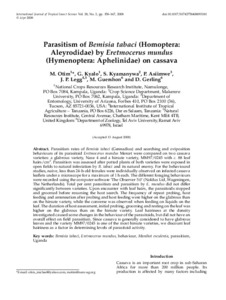| dc.contributor.author | Otim, M. |
| dc.contributor.author | Kyalo, G. |
| dc.contributor.author | Kyamanywa, S. |
| dc.contributor.author | Asiimwe, P. |
| dc.contributor.author | Legg, J.P. |
| dc.contributor.author | Guershon, M |
| dc.contributor.author | Gerling, D. |
| dc.date.accessioned | 2019-12-04T11:20:50Z |
| dc.date.available | 2019-12-04T11:20:50Z |
| dc.date.issued | 2008 |
| dc.identifier.citation | Otim, M., Kyalo, G., Kyamanywa, S., Asiimwe, P., Legg, J., Guershon, M. & Gerling, D. (2008). Parasitism of bemisia tabaci (homoptera: aleyrodidae) by eretmocerus mundus (hymenoptera: aphelinidae) on cassava. International Journal of Tropical Insect Science, 28(3), 158-167. |
| dc.identifier.issn | 1742-7584 |
| dc.identifier.uri | https://hdl.handle.net/20.500.12478/3531 |
| dc.description.abstract | Parasitism rates of Bemisia tabaci(Gennadius) and searching and oviposition behaviours of its parasitoid Eretmocerus mundus Mercet were compared on two cassava varieties: a glabrous variety, Nase 4 and a hirsute variety, MM970245 withc.88 leaf hairscm2. Parasitism was assessed after potted plants of both varieties were exposed in open fields to natural infestation byB. tabaciand its natural enemy. For the behavioural studies, naive, less than 24-h-old females were individually observed on infested cassava leaflets under a microscope for a maximum of 1 h each. The different foraging behaviours were recorded using the computer software ‘The Observer 5.0’ (Noldus Ltd, Wageningen, The Netherlands). Total per cent parasitism and parasitism by E. Mundus did not differ significantly between varieties. Upon encounter with leaf hairs, the parasitoids stopped and groomed before resuming the host search. The frequency of repeat probing, host feeding and anten nation after probing and host feeding were higher on the glabrous than on the hirsute variety, while the converse was observed when feeding on liquids on the leaf. The duration of host assessment, initial probing, grooming and resting on the leaf was higher on the glabrous than on the hirsute variety. Leaf hairiness at the density investigated caused some changes in the behaviour of the parasitoids, but did not have an overall effect on field parasitism. Since cassava is generally considered to have labrous leaves and the variety MM970245 is one of the most hirsute varieties, we discount leaf hairiness as a factor in determining levels of parasitoid activity. |
| dc.language.iso | en |
| dc.subject | Bemisia Tabaci |
| dc.subject | Eretmocerus Mundus |
| dc.subject | Behavior |
| dc.subject | Manihot Esculenta |
| dc.subject | Parasitism |
| dc.title | Parasitism of Bemisia tabaci (Homoptera: aleyrodidae) by Eretmocerus mundus (Hymenoptera: aphelinidae) on cassava |
| dc.type | Journal Article |
| dc.description.version | Peer Review |
| cg.contributor.affiliation | National Crops Resources Research Institute, Uganda |
| cg.contributor.affiliation | Makerere University |
| cg.contributor.affiliation | University of Arizona |
| cg.contributor.affiliation | International Institute of Tropical Agriculture |
| cg.contributor.affiliation | Natural Resources Institute, United Kingdom |
| cg.contributor.affiliation | Tel Aviv University |
| cg.coverage.region | Africa |
| cg.coverage.region | East Africa |
| cg.coverage.country | Uganda |
| cg.isijournal | ISI Journal |
| cg.authorship.types | CGIAR and developing country institute |
| cg.iitasubject | Cassava |
| cg.iitasubject | Plant Diseases |
| cg.accessibilitystatus | Limited Access |
| local.dspaceid | 95503 |
| cg.identifier.doi | https://doi.org/10.1017/S1742758408093181 |

